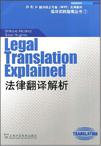法律翻译解析
出版时间:2008-7 出版社:上海外语教育出版社 作者:阿尔卡拉兹,休斯 著 页数:204
Tag标签:无
内容概要
该书以法律英语为核心,从语言学、法学以及译学三维角度对法律翻译进行较为全面和系统的诠释,内容涉及法律英语的特征、翻译等值论在法律语境中的适用、普通法体制、司法诉讼和行政裁决、法律文本体裁、词汇、句子翻译技巧以及其他一些常见的法律翻译技法,总体上能够满足法律英语翻译所需知识的基本要求。作为翻译研究理论著述,该书能用英语深入浅出地演绎法律翻译诸多深奥法则与技巧,实在是为母语为非英语之读者量身准备的一本难得的佳作。
作者简介
恩里克·阿尔卡拉兹(Enrique Alcaraz)、布赖恩·休斯(Brain Hughes)是西班牙阿利坎特大学英文教授,他们曾合著权威的《英语一西班牙语/西班牙语一英语法律术语词典》。
书籍目录
Foreword1. Some Pointers to the Linguistics of Legal English 1. Introduction: Legal English and the rise of English for professional purposes 2. The aims of the book 3. The leading features of legal English 4. 'Legalese' and 'The Plain English Campaign' 5. The classification of legal vocabulary 6. Some leading features of the morphology and syntax of legal English2. Equivalence and Interpretation 1. The question of equivalence in translation studies 2. Judges and translators. Interpretation and construction. The elusiveness of meaning 3. Lexical vagueness (Ⅰ). Definition, extension and intension 4. Lexical vagueness (Ⅱ). Denotation and connotation; register 5. Lexical vagueness (Ⅲ). Polysemy and the important of context 6. Lexical vagueness (Ⅳ). Homonymy 7. Vagueness in legal lexical units (Ⅴ). Synonyms, hyperonyms and hyponyms 8. Vagueness in legal lexical units (Ⅵ). Antonyms 9. Vagueness in legal lexical units (Ⅶ). False cognates or 'false friends' 10. Figurative language: metaphors and buried metaphors 11. Syntactic ambiguity 3. Some Pointers to the English Legal System 1. Introduction. The translator and the legal background 2. The translator and the sources of English law (a) Common Law (b) Equity (c) Statute law 3. The branches of English law. Jurisdiction and the court structure 4. The English Criminal Courts 5. The vocabulary of litigation 6. Common terms in litigations 7. The language of judges 8. The terms used in favourable judicial decisions 9. The terms used in unfavourable judicial decisions4. Civil and Criminal Proceedings. Administrative Tribunals 1. Introduction 2. Civil proceedings 2.1 The new 'Civil procedure rules' 2.2 The overriding objective 2.3 Unification of procedure 2.4 Allocation to track 3. Right of action, cause of action. Some basic terms 4. Criminal proceedings 4.1 Arrest and charge 4.2 Types of offences 4.3 The trial 5. Administrative, Industrial and Domestic Tribunals5. Genres in the translation o 4. Statutes 5. Law reports 6. Judgements 7. Oral genres (Ⅰ). The examination of witnesses at the public hearing 8. Oral genres (Ⅱ). Counsels' closing speeches to the jury [jury summation]. Judge's summing-up and charge to the jury6. Genres in the translation of legal English (Ⅱ) 1. Contracts 2. Deeds and indentures 3. Insurance policies 4. Last will and testament 5. The power of attorney 6. The professional article 7. Legal English in popular fiction7. Practical Problems in Translation Explained (Ⅰ) 1. Translation as problem-solving 2. Legal vocabulary (Ⅰ). The translation of purely technical vocabulary 2.1. Problems in the translation of one-word purely technical terms 2.2. Problems in the translation of multiple-word purely technical terms 3. Legal vocabulary (Ⅱ). The translation of semi-technical vocabulary 4. Legal vocabulary (Ⅲ) Problems in the translation of everyday vocabulary in legal English 5. The translation of functional vocabulary in legal English 6. Lexical resources in translation (Ⅰ). The collocations of legal English 7. Lexical resources in translation (Ⅱ). The semantic fields of legal English 8. Lexical traps for the translator: false cognates and unconscious calques8. Practical Problems in Translation Explained (Ⅱ) 1. The translator at the crossroads: techniques of legal translation 2. Transposition 3. Expansion 4. Modulation 5. Modifiers The complex noun phrase Verb phrase modifiers. Adverbs 6. The syntax of legal English. Double conjunctions 7. Thematization. Syntactic peculiarities of individual languages 8. Textual coherence. Lexical repetition in English legal discourse. SynonymsReferencesIndex
章节摘录
5. The classification of legal vocabularyProbably the greatest single difficulty encountered initially by legal translators is the unfamiliarity of the vocabulary characteristic of this type of discourse. Unfortunately there is no way round this problem except the deliberate process of learning. There is no magic wand one can wave. Nevertheless, it is possible to find some semblance of system in the legal lexicon, and this is the point of the present introductory section. Fuller discussion of the points raised here will be found in Chapter 7, which deals with problems of translation as they relate to vocabulary.As a first step, the lexical items found in any given language can be dividedinto two groups: symbolic (or representational) items and functional items. The latter type consists of grammatical words or phrases that have no direct referents either in reality or in the universe of concepts, but which serve to bind together and order those that do. Examples from the legal sphere are 'subject to', 'inasmuch as', 'hereinafter', 'whereas', 'concerning', 'under' and 'in view of'. Deictics, articles, auxiliaries, modals and other purely syntactic and morphological markers also belong with this group, as do other more complex units like 'unless otherwise stated', 'as in section 2 above', 'in accordance with order 14' and similar phrases (Harris 1997).The symbolic or representational group, on the other hand, includes all the terms that refer to things or ideas found in the world of reality, physical or mental. Legal terms of this type may be one-word units ('tort', 'court', 'law','right', 'adjudge', 'contract', 'misrepresentation', 'guilty', 'liable', etc.) or compound units ('serve proceedings', 'bring in a verdict', 'evidence in rebuttal' 'tenant from year to year', 'statute-barred claims', 'beyond reasonable doubt',and many others). This group may be further subdivided into three subgroups for any given specialist lexicon: purely technical vocabulary, semi-technical vocabulary, and shared, common or 'unmarked' vocabulary. Let us briefly examine each of these groups in turn.
编辑推荐
作为翻译研究理论著述,《法律翻译解析》能用英语深入浅出地演绎法律翻译诸多深奥法则与技巧,实在是为母语为非英语之读者量身准备的一本难得的佳作。
图书封面
图书标签Tags
无
评论、评分、阅读与下载
用户评论 (总计24条)
- 为考研准备的,还没开始看。准备先看看翻译学导论。
- 考研究生要用的,还挺难的,不过倒也全面。就是纸质不怎么好。
- 到手还没看~
- 质量不错,希望对我有帮助
- 刚拿到书,很好的一本书,纸质很轻的那种,摸着很舒服。
- 送来了,书蛮好
- 经典,绝对经典。
- 性价比很高,绝对值得一买
- 给同学买的,他要考翻译硕士
- 感觉这本书对自己的论文写作不太对路,可能自己的阅读水平有限,时间也紧,从中提取的东西有限。写的是功能目的论下商务合同的汉译研究
- 考mti不用买 也看不懂...
- 昨天收到书,挺好的,纸张封面的质量都可以。
- 感觉没太大收益,还不如看看法律发面的中文书
- 简介里说 文学是 简体中文 和英文的,,真是坑爹,除了封面,内容都是英文的。
- 条理清晰 内容实用 非常好用
- 书没什么问题,很快就拿到,价格也很有竞争力啊~
- 全英文的,对专业拓展有帮助!
- 非常喜欢 全英文的!满足了需要!内容也挺好
- 推荐,实用性较强,理论指导也很到位。
- 很好的法律书籍,值得购买
- 挺实用的书,深入浅出的,也不是太厚,心理负担小。
- 书很不错,同学很喜欢
- 书有好几页都破损了,有点影响心情~
- 学到很多东西。非常好
